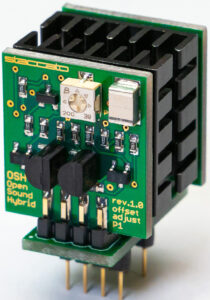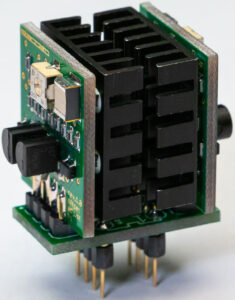I need some advice from the community.When I use my discrete opamps, they are generating heat and after an hour or two the room gets too warm. I have to put the AC on full, and my feet get cold. Does anyone know a solution?
That, of course, is a fantasy post to a fictitious forum. Discrete opamps, even those with little heat sinks —yes, some display relatively large ones — throw off negligible heat, though if one places their fingers close, it can be felt. It is a function of the bold new world of the High End that we have opamps sporting huge heat sinks! It reminds me of the Wells Audio Cipher DAC, which uses diamonds to dissipate heat in the signal processing because the switching rate is so high that a material with superior heat dissipation must be used. Don’t laugh at the idea of a beefy looking opamp with heat sinks, because they decimate the performance of cheap chip opamps that are used in most components!
When I first started rolling discrete opamps I never thought that I would still be investigating them ten years later! In the intervening time I have rolled a variety of opamps into the Eastern Electric Minimax DAC Junior, Minimax Tube DAC Supreme and, more recently, the Kinki Studio EX-M1+ Integrated Amplifier. These all take compatible pairs of single and dual discrete opamps, though the quantity varies between DAC and integrated amplifier. Positioning may be problematic for some brands/models in the EE Minimax DAC Junior due to sockets being closer to each other than in the Supreme. As well, in both units there can be diodes or other parts that thrust upward, blocking the opamp from seating properly. This is resolved through use of add-on risers to elevate the opamp a bit more.The representative opamps are from Burson (three generations), Sparkos Labs (two generations), and Sonic Imagery. Refer to my article Audio Blast: Return of the Discrete Opamp Roller for models. Here I explore a fourth company, Staccato Audio, as it also offers compatible, drop-in, single and dual discrete opamps.
Introduction to Staccato Audio
Staccato Audio is a small manufacturer of high performance discrete opamps, led by engineers Jakub Honkisz, who is the founder and project manager, and Morten Oksbierg, who designs the analog circuits. The company is implementing its plan to move beyond opamps to production of a lower power single ended class A solid state amplifier featuring dual mono design with sound quality able to compete with bespoke lower powered amps, such as the Audio Note Kondo ONGAKU. Jakub has offered me a listening test to the rev 3.3, and based on the performance of the Staccato discrete opamps, I accept the offer! If these men are able to pull off a feat as impressive with a preamp/amp combo as with the opamps, their work will be, ahem, noteworthy!
The company has been building opamps since 2017 and the current iteration is a hybrid using the BC560 transistor. Jakub describes some of the methods of the build: “In the production level we are matching input 2SK209 JFETs transistors from the batch of 1000psc, and also adjusting the output current to keep the same load for all three output pairs of 2SK2145. Class A needs to be cooled down, so we use heatsinks, which are good for thermal coupling of the crucial transistors, which are moved to under the heatsink.” The product is called OSH (Open Sound Hybrid). Such fine tuning takes much more production time but makes the opamp highly reliable and exquisite sounding.
Exquisite sound
My testing ground for these opamps was a simple setup involving the following system: Small Green Computer sonicTransporter, SONORE Signature Rendu with systemOptique, Clarity Cable Supernatural USB (1m), Eastern Electric Minimax Tube DAC Supreme, Iconoclast by Belden 4×4 “Generation 2” OCC RCA Interconnects (2m), Kinki Studio EX-M1+, Iconoclast SPTPC (Silver Plated Tough-Pitch Copper) Speaker Cables with locking banana plugs, and the refurbished Ohm Walsh Model F Speakers. All power cords used were the BAV (Belden Audio/Video) Power Cords.
The Ohm Walsh speakers have been an interesting project because they simply have not yielded the transparency that I expected from them. I just finished a review of the latest Ohm F5 speaker and was able to compare the two. The newer hybrid omni is distinctly better in terms of resolution. I have made it a project to elicit more refinement from the Model F. Placing Staccato opamps into the EE DAC and the EX-M1+ has been highly effective at gaining that resolution. Two distinct, powerful shifts upward in openness, richness, fullness, and smoothness occurred, first when I placed the Staccato opamps in the DAC and later when I placed them in the integrated.
The effect on vocals is particularly striking. Joan Baez’s “Diamonds and Rust” is one of my favorites for hearing into a recording, but it was recessed as heard through the Model F prior to the opamp changes. After the Staccato opamps were inserted, it seemed the gain had increased; the speaker could be played at the same listening level with the digital readout of the EX-M1+ several steps lower. At the same time, Joan’s voice was clearer, more evocative, and warmer. I adore products that bring both higher resolution and richer tonality, and these opamps do so. With other opamps, I’ve had to work with mixed sets to be assured of the optimal tonal balance, which is why I recommended purchase of all the brands’ products. But the Staccato opamps bring timbral correctness from the start. I am not saying there isn’t a highly favorable pairing of either the Staccato singles or duals with these other brands of opamps mixed into the DAC or integrated, but I do not feel a need, as with the others, to mix brands to get a highly satisfactory result. These are opamps you can buy and have confidence you will be gaining an exceptional result without having to work with mixing them with another brand. I did hear the dual Burson as well as the dual Sparkos Lab opamps with the single Staccato opamps in the EX-M1+, and in both cases preferred the use of the dual Staccato opamp in their place.
The influence of the Staccato products on the bass is another wonder. The Ohm Walsh Model 7 is not what one might call a prodigious bass performer, as it has a much less braced cabinet than is standard today and the full range driver fires down into the cabinet. It strains to cleanly render contemporary music, such as the single “The Runner” by Foals. Some insist that contemporary music with compression and a heavy LF signature is inappropriate for speakers like the Model F. There is some truth to that, as designs vary markedly, and in order to reproduce all music well a speaker needs to be quite capable. Single driver designs with six-inch or smaller drivers, cramped cabinets, or line source designs with smallish woofers and the like are not up to the task. Push such speakers in terms of listening level and there will be distortion. Often hobbyists blame the music, when the reality is the system is incapable of rendering the music well.
I encourage you to enjoy whatever music you wish on a speaker played at a reasonable level and, if it cannot handle the music, then it’s not all that much of a speaker. However, when the music sounds congealed, distorted, often it is not entirely the speaker at fault but the electronics.The owner cannot tell simply by guessing; one has to compare products, or improve them as with opamp rolling. When I hear the Model F before the Staccato opamps are inserted, I hear a speaker with limitations, but after they are inserted, I hear a speaker with potential. The difference in terms of the bass is a movement from looser, flabbier and more congealed notes to tighter, leaner and more distinct notes. There is less drop-off of low frequencies disappearing due to not being reproduced. Even the mushroom cloud soundstage of the speaker is improved!
- (Page 1 of 3)
- Next page →







Hi Doug
what would be the main sonic difference between these Staccato Kinki configuration and your previous Sonic Imagery Sparcos Labs Burson Kinki which I also have :)and now thinking of buying an extra Kinki EX-M1+
Anjo,
God’s Peace,
The Staccato opamps are the most dynamic and resolving, without being strident.
Blessings,
Douglas Schroeder
Hello Dough WOW that’s great to hear, besides the ex m1+ i’m also thinking of the ex p27 for what I know its full discrete although someone claims it has the socket for op-amps but i’m not sure maybe you have the answer.
best regards Anjo
Hello Doug,
Very interesting indeed! I am considering the EX M1+ and am wondering whether I would need risers in order to implement the Staccato op amps? Also in your experience which op amps are best placed and where within the amp?
Many thanks
David
David,
God’s Peace,
The risers are cheap and I keep about a dozen of them on hand for complete flexibility. The opamp maker may include some for you if you request. The best overall are the Staccato opamps throughout. But, opinions may vary depending upon other systems and preferences of sonic attributes. All these opamps are so cheap relatively speaking that I have them all and use them liberally. It is among the most economical system tuning methods I know.
Blessings,
Douglas Schroeder
Anjo,
God’s Joy,
I have not used the EX P27 and do not wish to speculate. I imagine that if you do a search for the component and “roll opamps” you will find plenty of discussion and confirmation if it does accept them.
Blessings,
Douglas Schroeder
Hey Doug, which model Duel opamp fit the min max dac. Thanks!
Dear Doug,
I was so excited to try the staccato op amps with my new Kinki EX-M1+. So ordered the op amps from Jakub. When they arrived I got to work. Opened up the amp and guess what they won’t fit without at least two risers on each op amp!!!!!!! In addition you need specific tools to extract the op amps off the circuit boards. I realize that inserting the Staccato op amps makes a HUGE difference BUT it is not an easy swap. Please let people know that it takes a”little skill” to do what you suggest. And you need special tools for op amp extraction and a magnifying glass to help with the op amp insertion. Somehow I was ignorant and believed that it was the same as changing tubes. IT is not!!!